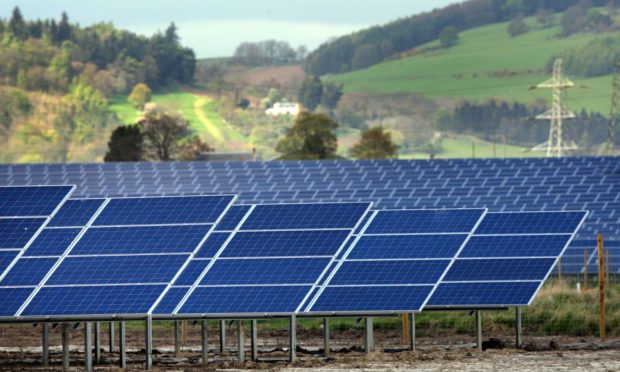Solar energy is making a comeback across Angus, Perthshire and Fife.
On the face of it, solar and Scotland do not appear to be happy bedfellows – why pursue sunshine energy in the land of leaden skies and dreich days?
But solar is the plucky underdog in the world of Scottish renewables and the distinctive panels are becoming a more familiar sight across our communities.
And what’s more, they’re set to become more even common.
Industry body Solar Energy UK says it will double capacity by 2030. It argues current UK capacity actually needs to treble if we are to hit climate change targets.
So it might be you live next to a solar farm. Or could be about to live next to one. Or maybe you are just curious about the neighbour’s solar panel roof conversion.
Whatever. Solar – or Solar Photovoltaic, or Solar PV, to use the tech’s Sunday name – is on the up.
So why now?
Solar panels and onshore wind turbines were two of the first forms of renewable technology to become common in Scotland.
As one of the blowiest countries in Europe, onshore and then offshore wind attracted the lion’s share of the investment.
But solar ploughed on regardless, capacity growing from two megawatts (MW) to 326 MW in 2016.
But then the UK Government pulled solar out of the main financial scheme that supports the renewables industry, Contracts for Difference.
Along with onshore wind, solar spent four years on the renewables naughty step with new commercial projects falling away.
But the UK Government has brought both technologies back from the cold. That puts commercial development – solar farms in other words – back on the table in a potentially big way.
Trade body Scottish Renewables predicted a “resurgence” in the technology in its 2020 annual report.
Solar PV technology is also getting cheaper all the time, driving demand.
Things are less sunny on the domestic front with solar panel owning homeowners still working out a new scheme to get payments for the power they put back into the grid.
The previous Feed in Tariff scheme had encouraged a lot of people to install solar in their homes.
Why the solar farms in Fife, Angus & Perthshire?
There is a 13MW solar farm in Errol, Perthshire. On opening it was the nation’s largest.
Smaller solar units are generating power across Angus and Fife as well as Perthshire. For example, the 4MW array by Wormit in the Kingdom.
There is also an ongoing application to build a giant 50MW farm at Berryhill in Angus.
The panels use photovoltaic tech to turn daylight into electrical power.
They don’t need scorching sun or a south facing spot (though like most of us they won’t say no to a spell or two…)
Our daylight hours, therefore, are sufficient for the panels, especially in the summer months.
In fact, experts say the potential in Scotland is similar to that in Germany – the largest Solar PV market in the world.
They highlight the huge potential in hitting climate change targets as well as targeting fuel poverty – an issue that is only too real for many living in our communities.
Critics, on the other hand, will argue that still doesn’t cut it and make claims the potential in Scotland can be as little as a third of that of a warmer European country such as Spain.
For those who find solar arrays unsightly, and there are a few, that’s a persuasive argument.
Why should big chunks of farmland turn into something, they say, akin to the Matrix films when there are more efficient renewables solutions out there?
Solar not (yet) a major player
Solar in Scotland is still relatively small potatoes. Of the 11,933 MW of capacity to generate renewable electric power in Scotland in the last part of 2020, only 271 were solar. That’s just over 2%.
That’s what makes the 50MW Berryhill proposal such an attention grabber. It has the potential to transform Scotland’s output.
Some solar critics argue solar is not needed at all – at least not at an industrial, farm-sized scale.
Scotland, after all, in 2020 only narrowly missed its target to generate the equivalent of 100% of its electricity demand from renewables.
But others have their eyes on Scotland’s promise to reach net-zero emissions of all greenhouse gases by 2045.
Solar champions are pushing the Scottish Government to include a clear target for solar as part of the nation’s journey.
They say Scotland’s solar potential – there is even talk of floating farms on Scotland’s 671 reservoirs – is woefully underutilised.
And that is surely about to change.









